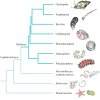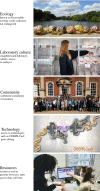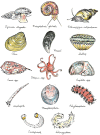Mobilizing molluscan models and genomes in biology
- PMID: 33813892
- PMCID: PMC8059959
- DOI: 10.1098/rstb.2020.0163
Mobilizing molluscan models and genomes in biology
Abstract
Molluscs are among the most ancient, diverse, and important of all animal taxa. Even so, no individual mollusc species has emerged as a broadly applied model system in biology. We here make the case that both perceptual and methodological barriers have played a role in the relative neglect of molluscs as research organisms. We then summarize the current application and potential of molluscs and their genomes to address important questions in animal biology, and the state of the field when it comes to the availability of resources such as genome assemblies, cell lines, and other key elements necessary to mobilising the development of molluscan model systems. We conclude by contending that a cohesive research community that works together to elevate multiple molluscan systems to 'model' status will create new opportunities in addressing basic and applied biological problems, including general features of animal evolution. This article is part of the Theo Murphy meeting issue 'Molluscan genomics: broad insights and future directions for a neglected phylum'.
Keywords: evolution; genomics; model organism; mollusc.
Figures



Similar articles
-
Molluscan phylogenomics requires strategically selected genomes.Philos Trans R Soc Lond B Biol Sci. 2021 May 24;376(1825):20200161. doi: 10.1098/rstb.2020.0161. Epub 2021 Apr 5. Philos Trans R Soc Lond B Biol Sci. 2021. PMID: 33813889 Free PMC article.
-
Molluscan mitochondrial genomes break the rules.Philos Trans R Soc Lond B Biol Sci. 2021 May 24;376(1825):20200159. doi: 10.1098/rstb.2020.0159. Epub 2021 Apr 5. Philos Trans R Soc Lond B Biol Sci. 2021. PMID: 33813887 Free PMC article. Review.
-
Potential of genomic technologies to improve disease resistance in molluscan aquaculture.Philos Trans R Soc Lond B Biol Sci. 2021 May 24;376(1825):20200168. doi: 10.1098/rstb.2020.0168. Epub 2021 Apr 5. Philos Trans R Soc Lond B Biol Sci. 2021. PMID: 33813884 Free PMC article. Review.
-
Single individual structural variant detection uncovers widespread hemizygosity in molluscs.Philos Trans R Soc Lond B Biol Sci. 2021 May 24;376(1825):20200153. doi: 10.1098/rstb.2020.0153. Epub 2021 Apr 5. Philos Trans R Soc Lond B Biol Sci. 2021. PMID: 33813894 Free PMC article.
-
MolluscDB: a genome and transcriptome database for molluscs.Philos Trans R Soc Lond B Biol Sci. 2021 May 24;376(1825):20200157. doi: 10.1098/rstb.2020.0157. Epub 2021 Apr 5. Philos Trans R Soc Lond B Biol Sci. 2021. PMID: 33813885 Free PMC article.
Cited by
-
A draft genome of the neritid snail Theodoxus fluviatilis.G3 (Bethesda). 2024 Mar 6;14(3):jkad282. doi: 10.1093/g3journal/jkad282. G3 (Bethesda). 2024. PMID: 38069680 Free PMC article.
-
Genome Evolution and Introgression in the New Zealand mud Snails Potamopyrgus estuarinus and Potamopyrgus kaitunuparaoa.Genome Biol Evol. 2024 May 2;16(5):evae091. doi: 10.1093/gbe/evae091. Genome Biol Evol. 2024. PMID: 38776329 Free PMC article.
-
Genome of the ramshorn snail Biomphalaria straminea-an obligate intermediate host of schistosomiasis.Gigascience. 2022 Feb 15;11:giac012. doi: 10.1093/gigascience/giac012. Gigascience. 2022. PMID: 35166339 Free PMC article.
-
A genetically tractable non-vertebrate system to study complete camera-type eye regeneration.Nat Commun. 2025 Aug 6;16(1):6698. doi: 10.1038/s41467-025-61681-6. Nat Commun. 2025. PMID: 40770180 Free PMC article.
-
Deep structure, long-distance migration and admixture in the colour polymorphic land snail Cepaea nemoralis.J Evol Biol. 2022 Aug;35(8):1110-1125. doi: 10.1111/jeb.14060. Epub 2022 Jul 13. J Evol Biol. 2022. PMID: 35830483 Free PMC article.
References
-
- Rosenberg G. 2014. A new critical estimate of named species-level diversity of the recent Mollusca. Am. Malacological Bull. 32, 308-322. ( 10.4003/006.032.0204) - DOI
-
- Gomes-dos-Santos A, Lopes-Lima M, Castro LFC, Froufe E. 2020. Molluscan genomics: the road so far and the way forward. Hydrobiologia 847, 1705-1726. ( 10.1007/s10750-019-04111-1) - DOI
MeSH terms
LinkOut - more resources
Full Text Sources
Other Literature Sources

